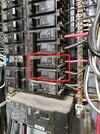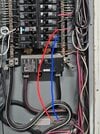Clearly, not everyone could understand the whole point of the testing. I won't try to argue more which does nothing constructive regarding to the original post. But I would kindly ask you to read the temperature of the hot wire which comes nowhere close to melting down (hello rationale). Nevertheless, we are all trying to be safe at the end of the day and if we both agree on this then we are on the same boat.
All right. Let's make this clear: I
am a EE. I've got my cutesy little Order of the Engineer ring on my right pinky, where it's been since I was an undergraduate. One of the oaths I took was To Not Endanger the Public.
On average, I suppose, I've waved that pinky finger at supervisors and such on average two or three times a decade. I work with a good crowd: One wave, in general, is all it takes. And, in all those times, it was about Things Catching Afire. Which, very definitely, endangers the public if it occurs.
On top of all this, one of my lines of work has been to take dead, broken, and burned (I am
not kidding here) things returned from the field, figure out what happened, and fix whatever it was to Never Happen Again.
On the one hand, I am not a true-blue AC city power engineer, the kind with the yellow hats and all. On the other, I mess with central office 48V power which, given the way things work, can get up into the thousands of amperes. (Although, I usually don't get that high. Tens of amps with an occasional diversion to 100A is more my shtick.
But this puts what I work on, and what Teslas do on power, in the same rough range. So.. I have a feel for this kind of thing. And, yeah, I
do know how breakers are put together. And how fusing works. I got my I^2-t curves under full control.
You and your, "Testing", I'm afraid, leaves something to be desired. First off, there's manufacturing variations on breakers. The trip current for these things is statistical and not exact. Which means that what works on one breaker, even several times, isn't going to work across a whole population of breakers. Unless you've been reading some serious data sheets, I question whether your, "experiments" have any real validity.
Second: While there are certain types of breakers that don't have the wear-out mechanisms that most commercial breakers do (magnetic trip ones, for example), you're not going to find them at Home Depot or your typical electrical supply store. The commercial ones work by heating up an element. When that element gets hot, it expands, gets bigger, and pushes against some kind of trip lever. It.. flexes.
Running any breaker right at its limit wrecks its reliability equation. The FIT rate is going to soar, and the probability of that breaker failing gets to be high.
And then one has to ask about failure modes. This is where
how a breaker fails likely varies on a manufacturer-by-manufacturer basis. Failing open is one thing. But breakers do fail closed, and That Is Dangerous.
There are good, solid reasons that don't take much thought from an engineer, any engineer, why the NEC calls for a max steady load of 80% of the circuit rating. It's to keep that breaker safe. For that matter: Screw down terminals are high-resistance (relatively) points that also expand and contract. with high current. All of this says: Stay away from 100% usage!
You're playing, or think you're playing, Penny-Wise. But it's not just, "Pound foolish". Breakers are
safety equipment, as in people's actual safety against physical harm. You are playing, "dicing with death". That typically does not end well.
Or you're here to play troll. Which is it?




